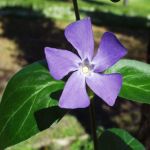| Common Name: |
Greater Periwinkle |
| Botanical Name: |
Vinca Major |
| Genus: |
Vinca |
| Family: |
Apocynaceae |
| Native Location: |
W. Meditteranean |
| Cultivation: |
Moist soil in sun or partial shade. Invasive. Cut back plants in autumn or winter to control spread. Remove excess shoots in summer to restrict spread before rooting at nodes takes place. Leaves may be damaged by rust. |
| Propagation: |
By division from autumn to spring; by semi-ripe cuttings in summer. |
| Harvest: |
Plants are cut when flowering and processed commercially for alkaloid extraction, or dried for use in infusions, liquid extracts, powders and tinctures. |
| Variations: |
alba
Has white flowers. |
Maculata
Has leaves with yellow-green centers. |
oxyloba
Syn. 'Dartington Star', 'Hidcote Purple'
Bears deep violet-blue flowers with pointed lobes. |
Reticulata
Has yellow-veined leaves. |
Variegata
Syn. Elegantissima
Has leaves with irregular cream variegation. |
|
| Height: |
45cm (18in) |
| Width: |
Indefinite |
| Hardiness: |
Z7-9 |
| Parts Used: |
Whole Plant |
| Properties: |
An acrid, slightly bitter, astringent herb that controls bleeding. |
| Medicinal Uses: |
Internally for heavy menstruation and enurensis. Externally as a douche for vaginal discharge. |
| Warning: |
Toxic if eaten. |
| Bibliography: |
The Encyclopedia of Herbs by Deni Bown Copyright © 1995, 2001 Dorling Kindersley Limited. pg 404
|
